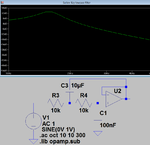kaSva
Junior Member level 1
I get this schematic from industrial device. This schematic uses for 4-20mA sensor input on this device. I create same circuit on breadboard. But it didn't work. I used 741 op-amp. But Industrial device used 27L2C. Please tell me why didnt work?
27L2C datasheet https://www.ti.com/lit/ds/symlink/tlc27l2a.pdf
Circuit Schematic:

27L2C datasheet https://www.ti.com/lit/ds/symlink/tlc27l2a.pdf
Circuit Schematic:




